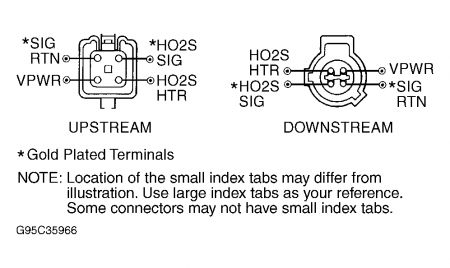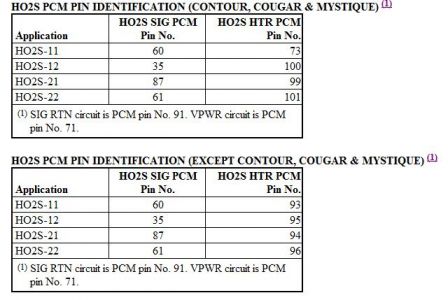FLI PID is fuel level input paremeter identification .. P1000 is telling you the PCM is not able to complete self test .. which it won't because of the PO161 fault code .. try these tests ?
30) DTC P0135, P0141, P0155 Or P0161
DTCs received separately indicate a short to ground or open circuit in HO2S heater circuit. DTCs received in pairs, such as P0135 and P0155 or P0141 and P0161, indicate HO2S heater circuit is shorted to a power source of more than 2 volts. HO2S DTC identification is as follows:
DTC P0135 is for HO2S-11.
DTC P0141 is for HO2S-12.
DTC P0155 is for HO2S-22.
DTC P0161 is for HO2S-22.
Refer to illustrations for HO2S identification.
Possible causes are:
Signal shorted in wiring harness or HO2S.
Water in connectors.
Cut or pulled wires.
Open in GND or VPWR circuit.
Corroded terminals.
Faulty HO2S heater.
Inspect HO2S connectors for loose, damaged or corroded terminals. Repair as necessary. If HO2S connectors are okay, go to next step.
31) Perform KOEO Self-Test
Start engine and operate at 2000 RPM for one minute. Turn ignition off. Perform KOEO ON-DEMAND SELF-TEST. If DTC P0135, P0141, P0155 or P0161 is present, go to next step. If specified DTCs are not present, fault is intermittent. Go to TEST Z.
32) Check For Voltage At HO2S Heater Wiring Harness Connector
Turn ignition off. Disconnect suspect HO2S. Inspect wiring harness for damage and repair as necessary. Turn ignition on. Measure voltage between SIG RTN and VPWR terminals at suspect HO2S wiring harness connector. If voltage is more than 10.5 volts, go to next step. If voltage is 10.5 volts or less, check circuit fuse. Replace as necessary. If fuse is okay, repair open circuit.
33) Check HO2S Heater Resistance
Turn ignition off. With suspect sensor disconnected, measure resistance between HO2S HTR terminal and VPWR terminal at suspect HO2S. If resistance is 3-30 ohms, go to next step. If resistance is not 3-30 ohms, replace HO2S.
34) Check HO2S Case For Short Circuit
Measure resistance between HO2S HTR terminal at HO2S and HO2S case. Measure resistance between HO2S HTR terminal and SIG RTN terminal at HO2S. Also measure resistance between VPWR terminal at HO2S and HO2S case. If all resistance readings are more than 10,000 ohms, go to next step. If any resistance reading is 10,000 ohms or less, replace HO2S.
35) Check For Short Circuit
Disconnect scan tool from DLC. Disconnect PCM 104-pin connector. Inspect connector for loose, damaged or corroded terminals. Repair as necessary. Measure resistance between HO2S HTR terminal and SIG RTN and VPWR terminals at suspect HO2S wiring harness connector. See Fig. 103 or Fig. 104 . If both resistance readings are more than 10,000 ohms, go to next step. If any resistance reading is 10,000 ohms or less, repair short circuit.
36) Check For Open Circuit
Leave ignition off and HO2S disconnected. Measure resistance between HO2S HTR terminal at suspect HO2S wiring harness connector and appropriate HO2S HTR pin at PCM connector. See HO2S PCM PIN IDENTIFICATION (CONTOUR, COUGAR & MYSTIQUE) table. See Fig. 103If resistance is 4 ohms or more, repair open circuit or excessive resistance in wiring harness. If resistance is less than 4 ohms, replace PCM.


Monday, February 16th, 2009 AT 12:51 PM




